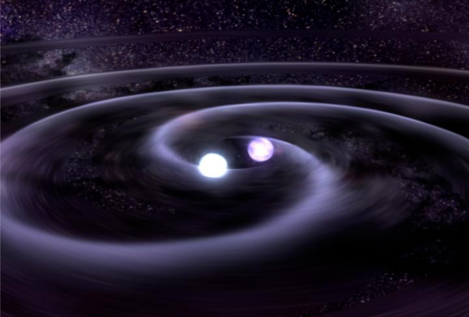Imagine a star twice the mass of the Sun crushed to the size of Manhattan. The result would be a neutron star, one of the densest entities in the Universe, denser than any material naturally found on Earth by a factor of tens of trillions.
Image Credit: NASA/Goddard Space Flight Center.
Neutron stars are unusual astrophysical entities in their own right, but their highest density could also allow them to act as laboratories to study fundamental questions in nuclear physics in environments that could never be replicated on Earth.
Because of these unusual circumstances, researchers still don’t know exactly what neutron stars are made of, their so-called “equation of state” (EoS). Determining this is a central goal of modern astrophysics.
A new piece of the puzzle that narrows the range of possibilities has been uncovered by two Institute for Advanced Study (IAS) scientists: Carolyn Raithel, John N. Bahcall Fellow in the School of Natural Sciences; and Elias Most, a member of the school and a John A. Wheeler Fellow at Princeton University. Their research efforts have recently been detailed in The Letters of the Astrophysical Journal.
Researchers would love to get a glimpse inside these mysterious objects, but they are very small and far away to be imaged with ordinary telescopes. Researchers rely on indirect features they can quantify — like a neutron star’s radius and mass — to measure the EoS, the same way one would measure the lengths of two sides of a right triangle to find its hypotenuse.
Still, it is very difficult to accurately quantify the radius of a neutron star. A convenient substitute for future observations is to use a measure known as “peak spectral frequency” (or f2) at his place.
But how do you measure f2? Collisions between neutron stars, obeying the laws of Einstein’s theory of relativity, result in powerful bursts of gravitational-wave emission. In 2017, researchers were able to quantify such emissions for the first time.
In principle, at least, the spectral peak frequency can be calculated from the gravitational-wave signal emitted by the wiggling remnant of two neutron star mergers.
Elias Most, Faculty of Science, Institute for Advanced Studies
It was previously projected that f2 would be a realistic substitute for the radius, since scientists previously assumed that there was a direct or “quasi-universal” correspondence between them. However, Raithel and Most have shown that this is not always the case. They showed that setting up the EoS is different than solving a basic hypotenuse problem. Rather, it is similar to measuring the longest side of an irregular triangle, where you also need a third piece of information, which is the angle between the two shorter sides.
For the two researchers, this third piece of data is the “slope of the mass-radius relationship,” which translates data about the EoS at higher densities (and thus more extreme circumstances) than just radius.
This discovery will allow scientists involved in the next generation of gravitational-wave observatories (the successors to the currently operational LIGO) to make better use of the data collected after neutron star collisions. Raithel believes this data could reveal the core elements of neutron star matter.
Some theoretical predictions suggest that phase transitions within neutron star cores could break up the neutrons into subatomic particles called quarks. That would mean that the stars contain a sea of free quark matter inside. Our work can help tomorrow’s researchers determine whether such phase transitions actually occur.
Carolyn Raithel, John N. Bahcall Fellow, School of Natural Sciences, Institute for Advanced Studies
Doomed neutron stars produce flashes of light and gravitational waves
Video credit: Institute for Advanced Study
magazine reference
Raithel, CA & Most, ER (2022) Characterizing the collapse of quasi-universality in postmerger gravitational waves from binary neutron star mergers. The Letters of the Astrophysical Journal. doi.org/10.3847/2041-8213/ac7c75.
Source: https://www.ias.edu/
#Scientists #tool #neutron #stars


Leave a Comment